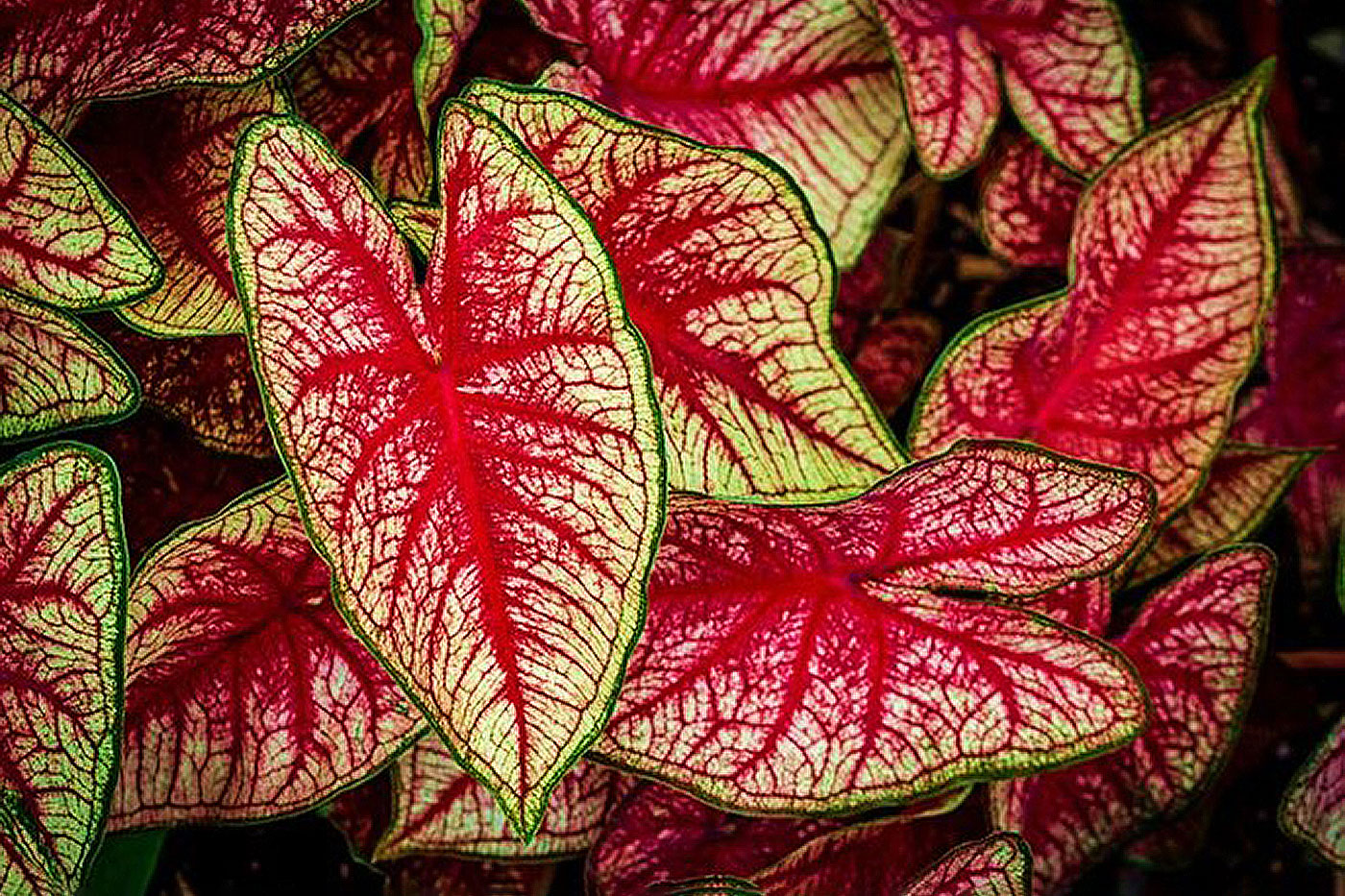
(Credit: Pixabay)
When it comes to adding striking color to shady landscape areas, few plants can match caladium. Prized for their colorful, thin leaves, they add a translucent quality to the garden when the early morning or late evening sun shines upon them. Because of their ability to provide ostentatious shows of color with minimal amounts of sunlight, caladiums could be considered the "peacocks of the shade," at least in the plant world.
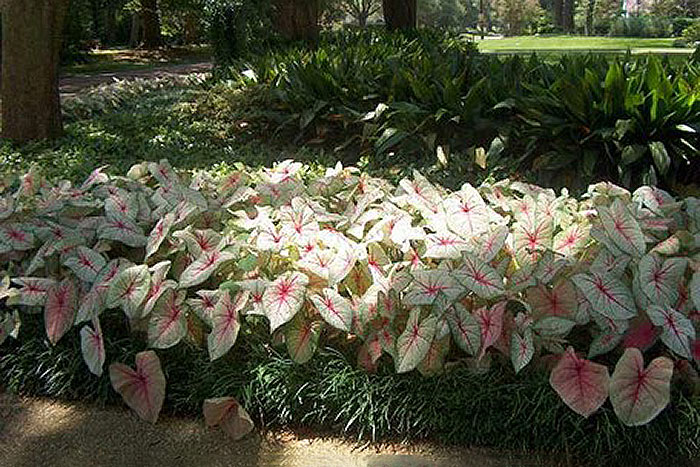
Caladium is one of the few ornamental plants that can provide good color in shady areas. (Credit: Missouri Botanical Garden)
Caladium is both the genus and common name of this popular garden plant that is a member of Araceae plant family. There are about 14 species in the genus, most of which are native to Central and South America. The caladium most often planted by gardeners carries the scientific name of Caladium x hortulanum, which indicates it is hybrid derived from crossing various species (especially, Caladium bicolor). There are over 1000 named cultivars of caladium available to today.
Considered to be somewhat of an "old-fashioned" plant, caladiums were first cultivated by gardeners in Europe late in the 1800th century. Plants exhibit what is known as a basal habit of growth. This means they do not produce stems. Instead, leaves on long petioles arise directly from its underground storage structure which is a tuber.
The gardening world recognizes two main types of caladiums, based on their leaf shape. The "fancy-leaved" types have large cordate leaves with a deeply incised base. Fancy-leaved types might reach a mature height of 15 to 24 inches. In contrast, shorter "strap-leaved" types have narrower leaves that are more lanceolate in shape. Their shorter petioles limit their mature height to about 12 inches. In both cases, leaves typically have prominently colored midribs, contrasting margins, and patterns including veined, mottled, and striped. Caladiums are available in a wide array of colors including shades of green, white, pink, rose, and red.
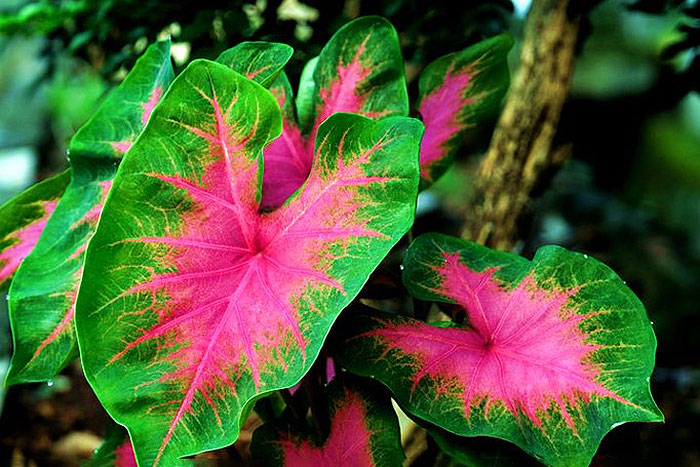
Fancy-leaved caladiums have leaves that might approach 12 inches in length. (Credit: Pixabay)
The inflorescence of a caladium botanically is known as a "spathe." The latter contains a fleshy, central column containing many small flowers which are surrounded by a specialized bract known as a spathe. Caladium blooms are not considered to have ornamental value by most gardeners. Therefore, they are removed at their first appearance, so the plant puts all of its energy into foliage production and tuber enlargement.
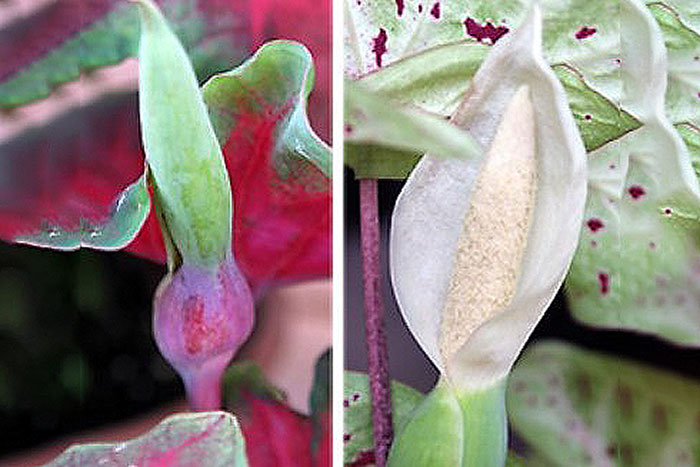
The infloresence of a caladium is called a spathe and is not consider to have ornamental value. (Credit: University of Wisconsin)
Because of their tropical nature, caladiums need warm temperatures to get off to a quick start and often are started in greenhouses or bright locations in the home. Night temperatures where they are started should be near 70 degrees F.; day temperatures may be even higher. Use a growing medium high in organic matter when starting them. Prepackaged soilless potting mixes used for houseplants make satisfactory media for starting caladium tubers.
When starting caladium tubers for later outdoor planting, place them in a three to four-inch diameter pot. If in doubt concerning which side of the tuber is up when planting, plant them with their "bumpy" side up. Caladiums also may be used an indoor potted plant. If this is done, several tubers should be placed in a five or six-inch pot. Tubers need to be only slightly covered when being forced indoors. Light is not immediately necessary, but pots should be moved to a bright location as soon as leaves appear.
As mentioned above, the underground storage structure of a caladium botanically is classified as a tuber. Tubers are specialized underground stems. As with stems that grow above ground, they have nodes containing dormant buds (often referred to as eyes) as well as internodes. Normally, each caladium tuber contains a dominant center bud, along with several smaller buds surrounding it.
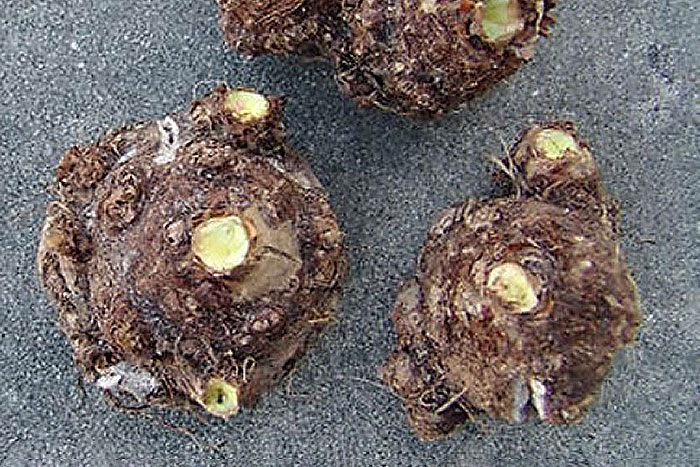
Example of caladium tubers whose dominant central bud has been removed prior to planting. (Credit: University of Florida)
The apical dominance exerted by the dominant bud often delays the development of the surrounding buds. There are several methods used to stimulate the development of the smaller (side) buds to produce a multi-leafed plant fuller in appearance. One method for doing this simply is to place the tuber upside down when planting. This delays the emergence of the center bud and allows the smaller ones to develop. Another approach is to remove the dominant bud with a sharp knife before planting. Using the tip of the knife, carefully make a shallow cut around the dominant bud and "flip" it out. This will stimulate the development of the side buds.
Never plant caladiums outdoors until the soil has warmed and the danger of frost has passed. Their leaves are easily damaged by frost and plants grow poorly in cool weather. For central Missouri, planting the last week of May is considered satisfactory. When planting started plants in the garden, set them only slightly deeper than they were growing in the pot. Ideally, the tuber should be about one inch below the surface of the soil.
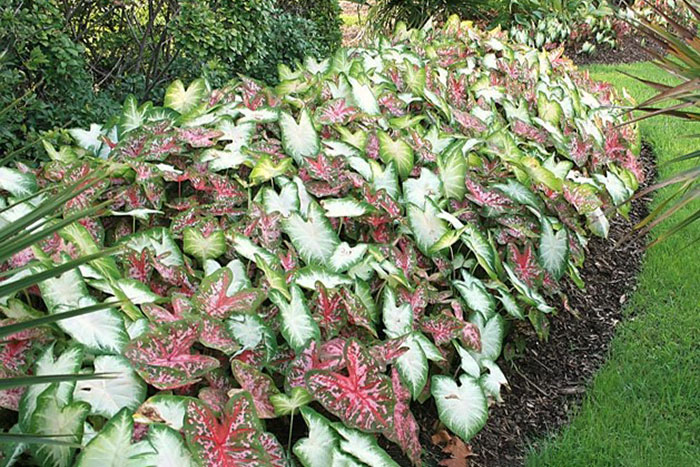
Caladiums prefer a moist, well-drained soil high in organic matter. (Credit: Mississippi State University)
Caladiums prefer a moist, rich, and well-drained soil, so it is best to amend most soils with plenty of compost or other organic material. Additionally, they need an abundant supply of water and nutrients throughout the growing season to thrive. When planted near shrubs or trees that have roots that compete for moisture, water is extremely important, especially during periods of dry weather. If caladiums become too dry, leaves will die and fall off, and growth may stop even though wilting is not apparent. Mulch applies around the base of the plants can help to maintain a uniform moisture supply.
Caladiums are not winter hardy at our latitude. To reuse tubers the following year, they must be harvested in the fall of the year when the danger of frost approaches. Carefully lift the tubers along with their leaves and shake off excess soil. Allow the tubers to dry in a warm, shady location for about one week. Remove withered leaves and store tubers in peat moss or another suitable material at a temperature between 55 to 60 degrees F.
Elephant ear (Colocasia esculenta) is a close relative of caladium and also is a popular garden plant. The species has leaves that are solid green and extremely large. Certain cultivars of the species (e.g., 'Black Coral') have leaves that are heavily pigmented to the point of appearing nearly black. Elephant ear plants may reach a height of four to five feet. In all cases, elephant ear plants need abundant moisture and may be used near pools or in low, moist areas.
Unlike caladium, elephant ear can tolerate full sun or light shade, given it is provided with adequate amounts of water. Elephant ear tubers are very large when compared with those of caladium. Although they may be started indoors in larger pots (i.e., six to eight-inch), their rapid growth rate will necessitate them to be set outdoors soon after leaves emerge from the container. For this reason, elephant ear tubers often are planted directly into the garden as soon as the soil has warmed in late May.
A related species, Colocasia gigantea 'Thai Giant' is similar in appearance to elephant ear but produces leaves up to 48 inches across. It makes a spectacular accent plant in the garden. Although not the easiest plant to find a spot for in the landscape, it does possess the "wow" factor.
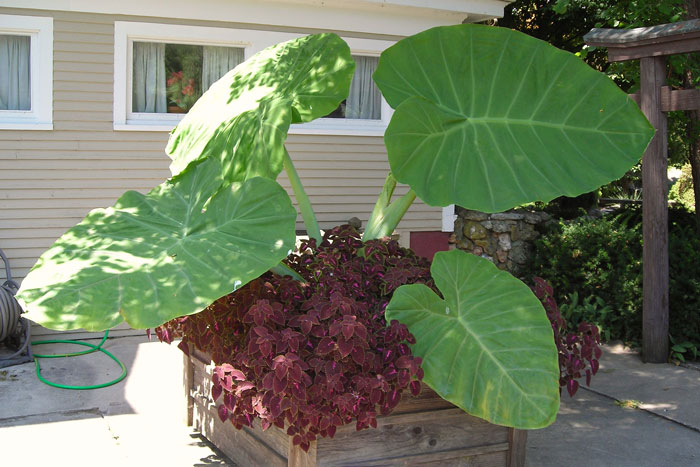
Few garden plants have the "wow" factor of 'Thai Giant' elephant ear.